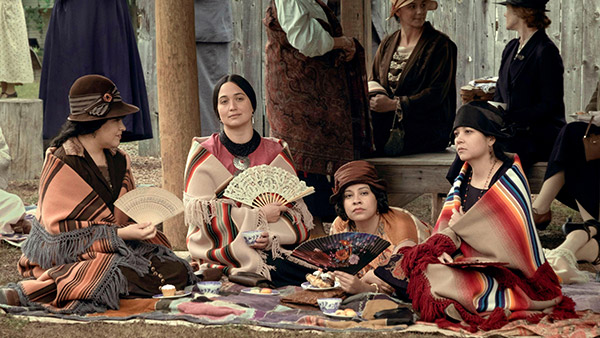Subtotal: $
Checkout
The Price of Guilt
Martin Scorsese’s Killers of the Flower Moon asks hard questions about greed, guilt, and race.
By Chris Zimmerman
November 14, 2023
Containing all the elements of a classic Western, Martin Scorsese’s latest movie, Killers of the Flower Moon, packs a punch, but it is also psychologically complex and deeply spiritual, and leaves the viewer pondering existential questions: Why does guilt drive some people to remorse, and others over the edge? What is the strange calculus of greed that causes it to catch up with even the most cautious, best-intentioned person? What is the power of a lie, that it can blind a person to a truth staring him in the face? How is it that what seems to be a blessing often turns out to be a curse – that a stroke of good fortune sometimes spells the worst fate?
At a time when certain fraught subjects are polarizing the country, this film boldly confronts one – racism – without forcing or politicizing the issue. It shows us that, more often than not, cultural and ethnic differences are indeed a deciding factor in determining one’s destiny, and that, like it or not, human history mostly plays out as a struggle between the oppressor and the oppressed. And finally, it explores the ways conventional piety and genuine faith intersect (or clash) and raises that ancient and uncomfortable question: Who is my neighbor?
Set in the 1920s, Killers of the Flower Moon takes an unflinching look at what happened to the people of the Osage Nation after settlers drove them from their ancestral villages in what is now Missouri. Left to fend for themselves on the barren prairies of Oklahoma – barren, except for the petroleum they discovered spurting from underground reservoirs – they soon became the envied beneficiaries of wealth promised by the twentieth century’s most prized natural resource. Almost overnight they found themselves at the center of a frenzied latter-day gold rush. In the process, the unremarkable trading post of Fairfax morphed into a boomtown with flappers and hoodlums, banks and saloons, an airstrip, a Tiffany’s counter, and the highest concentration of Franklin Pierces in the country.

Lily Gladstone in Killers of the Flower Moon (2023) Album / Alamy Stock Photo
For some, the phrase “blood for oil” conjures up the Gulf Wars, but as Scorsese demonstrates, it’s a far older theme – witness the droves of gun-slinging young venture capitalists who flock to the Osage territory and are soon marrying its women for money. Why? For the simple reason that the only way to acquire a share of the tribe’s coveted mineral rights is by inheriting them or acquiring them as next-of-kin, in the event of a death. And voilà, there are bodies: first as a result of a mysterious wasting disease that takes one Osage woman after another, and then because of a string of brutal murders. (Since none of them is investigated, none is solved – not by the local sheriff, and not by the justice of the peace, who, it turns out, is interested in neither.)
Enter Ernest Burkhart (Leonardo DiCaprio). A fresh-faced army cook newly returned from overseas, he soon falls in love with a radiant native beauty named Mollie Kyle (Lily Gladstone) – or more accurately, is nudged into wooing her by his uncle, William “King” Hale (Robert De Niro). Hale is a servant of Manifest Destiny armed with a Bible verse for every occasion. More importantly, he has an impressive command of the Osage language and is a trusted go-between for the tribe and the settlers who have flocked to its oil wells. He is the suave voice of experience at every council meeting, and an avuncular presence at every gathering, from communal ceremonial rites to weddings and funerals.
Funerals: they keep popping up in this film, for dying haunts its trajectory from beginning to end. It also highlights the contrast between the restless duplicity of Ernest and company and the serenity of Mollie and her people. That contrast is steadily heightened once she herself falls sick. Spoiler alerts won’t prevent anyone from guessing why: suffice it to say that her husband is not the gentle partner he appears to be, and that if left undiagnosed and unchecked, the cancer of avarice can kill a soul as surely as a chemical can kill a body.
That Mollie still loves Ernest complicates the picture, but doesn’t really alter it: even the most amorous attentions and the smoothest talk cannot save this marriage. It doesn’t help that he feels emasculated by the private jeers of his drinking buddies (they call him “squaw man”) and is kept awake at night by the gnawing of a bad conscience. “The heart is deceitful above all things,” says Jeremiah – and the killers at the center of this story, who are so twisted by deceit that they come to believe their own lies, bear out that truth.
Given that this film is, at least on one level, a Western, it seems noteworthy that it is quietude – not action – that suffuses it. True, there are wild shoot-outs, and early morning often finds the men of Fairfax stumbling home from bourbon-fueled barroom brawls. But it’s the way Mollie greets the dawn that has staying power: prayerful and alone, at the brook below her house, awaiting the first rays of sunlight and communing with Wa-Kon-Tah, the Great Spirit. (In another scene, during a nighttime thunderstorm, she cuts off Ernest midsentence to listen to its voice.) It is this power – a grounding in the eternal – that gives her the courage to defy her husband and his uncle and, even though she is now deathly ill, to travel to Washington, D.C., where she begs President Grover Cleveland to intervene in the reign of terror afflicting her people.
Meanwhile, the uneasiness which dogs Ernest and his cronies finds them continually slipping into what the Osage call “blackbird talk” – the filling of uncomfortable conversational gaps with the sort of back-alley chatter that makes its way through town and, after the Feds arrive, eventually entraps them. (In a jailhouse scene weighted with irony, Hale pleads with his no longer submissive nephew not to turn state’s evidence, but to remain silent “for the sake of your family.”)
Mollie, for her part, never wastes an extra syllable if one will do. At the climax of the drama – a moment Shakespearean in its building tension and sudden relief – she rises, regal and invincible. Then, wordlessly rebuffing her husband, who has finally been caught in his own net, she turns her back on him and exits the room. There is no need to justify herself. Truth itself vindicates her.
Killers of the Flower Moon might have ended here. Instead, it proceeds to a daring denouement that includes a cameo appearance by Scorsese himself in an early true-crime radio show that reviews the investigation of the murders and its outcome. Daring, because he seems to be questioning his own medium by reminding us how easily the cruel fate of one person (or people) can become the stuff of cinematic entertainment for the next. But it is also fitting, because by virtue of a film, it’s far more likely that the victims of this little-known chapter of American history will not be forgotten.
Already a subscriber? Sign in
Try 3 months of unlimited access. Start your FREE TRIAL today. Cancel anytime.







Francis Wardle
I have read the book; but not seen the movie (I am not a fan of movies, so probably will not watch it). My late wife was a member the Chickasaw tribe (also in Oklahoma). While I appreciate this review, it has left out a central fact (as many seen to): the requirement of the US Government that First Americans who acquire money must have an "official" White counselor to handle their money, because at the time they were considered to be incompetent of doing so on their own. This is an extremely important point, because it parallels the justification of Black servitude because "they are not capable of caring for themselves, and thus require White people to protect them". It's this kind of deep institutional racism that enabled these horrible events to take place.